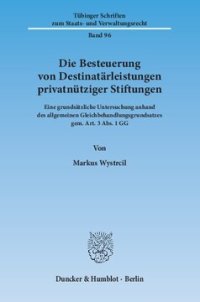
Ebook: Die Besteuerung von Destinatärleistungen privatnütziger Stiftungen: Eine grundsätzliche Untersuchung anhand des allgemeinen Gleichbehandlungsgrundsatzes gem. Art. 3 Abs. 1 GG
Author: Wystrcil Markus
- Series: Tübinger Schriften zum Staats- und Verwaltungsrecht, 96
- Year: 2014
- Publisher: Duncker & Humblot
- Edition: 1
- Language: German
- pdf
Der Band befasst sich mit der einkommen- sowie erbschaft- und schenkungsteuerrechtlichen Behandlung von Leistungen einer Stiftung an ihre Begünstigten. Unsicherheit ist insofern aufgekommen, als zum 1.1.2001 ein neuer Tatbestand von Einkünften aus Kapitalvermögen geschaffen worden ist, der anwendbar sein könnte, auch auf Auskehrungen bei Auflösung der Stiftung. Einkommensteuerrechtlich befasst sich der Band mit der grundlegenden Einordnung der Leistungen zu einer Einkunftsart. Da das einfache Gesetzesrecht auch nach tiefgründiger Analyse keine klare Antwort zu geben vermag, rekurriert der Autor auf das verfassungsrechtliche Gebot der Folgerichtigkeit und arbeitet Kriterien heraus, mit denen eine zutreffende Einkünftequalifikation gelingen kann. Erbschaft- und schenkungsteuerrechtlich wird beleuchtet, ob Auskehrungen bei Stiftungsauflösung dieser Steuer unterliegen. Es wird eine Lösung entwickelt, die auch insoweit einer folgerichtigen Besteuerung gerecht wird, zumal im Zusammenspiel der beiden Steuerarten.In particular in absence of capable and willing successors, a foundation may be a means for an appropriate succession planning structure. Unlike distributions from corporations, in Germany the tax treatment of distributions received by the foundation's beneficiaries is far from being clear. Ongoing distributions had generally been classified as other taxable income (sec. 22 no. 1 of the Income Tax Act, ITA). But with effect from 2001, a new income element has been introduced in sec. 20 sub. 1 no. 9 of the ITA. According to this, distributions are considered to be a sort of income from capital investments, if they are – viewed economically – comparable to profit distributions form a corporation. However, the provision does not say, when distributions do so. This raises the questions, whether and to what extent this could be affirmed, and, what this means with respect to sec. 22 no. 1 of the ITA. In addition, sec. 20 sub. 1 no. 9 of the ITA also applies in case of dissolution, although the transfer of assets to the beneficiaries also triggers inheritance and gift tax. Therefore and in order to bring the relevant provisions or at least their application in line with the overall system of taxation as well as the constitution, esp. the principle of equal treatment, distributions are to be qualified as an income from capital investments, if – roughly summarized – the respective beneficiaries (i) are determined as the final recipients of both the foundation's income and principal, (ii) are in a position to exert significant influence on the statutory bodies and to get income distributed, and (iii) do actually receive such income. As a consequence, if these requirements are met, the distribution of retained income is allowed to be taxed with income tax as well when dissolving the foundation, but not with inheritance and gift tax; the latter is only to be based on distributed principal.
Download the book Die Besteuerung von Destinatärleistungen privatnütziger Stiftungen: Eine grundsätzliche Untersuchung anhand des allgemeinen Gleichbehandlungsgrundsatzes gem. Art. 3 Abs. 1 GG for free or read online
Continue reading on any device:

Last viewed books
Related books
{related-news}
Comments (0)